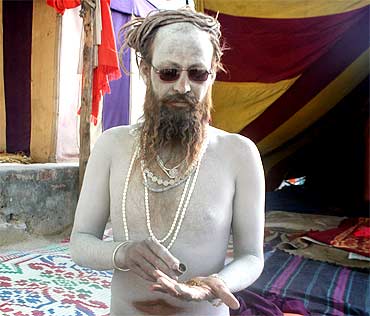Photographs: Reuben NV
Rediff.com's Sanchari Bhattacharya and Reuben N V travelled to Haridwar to be a part of the world's largest religious gathering, and spent some time with the famous yet mysterious Naga Sadhus.
They are one of the most popular attractions of the Kumbh Mela. They are a visual delight for photographers, an enigma for true devotees and on the itinerary of every foreign tourist.
Ironically, the Naga Sadhus also happen to be the most low-profile and reclusive bunch of saints at the religious gathering. Their decrepit tents, frill-less blessings and reluctance to talk to the media are in sharp contrast to the ostentatious camps, five-course prasads and PR mechanisms of the other holy men at the mela.
Unless they venture out for a Ganga Snan (ritual bath) or other religious quests, they are difficult to find in the overcrowded fair populated by scores of sadhus. Peacefully tucked away in a by-lane of Haridwar, Naga Sadhus prefer to stay away from the scrutiny and glare of the media and tourists alike. Their reputation of being volatile and unpredictable also helps in keeping many devotees away.
But when some enterprising tourists and overzealous journalists do make their way to their remote ashram, these sadhus gladly share their stories and their ganja chillums. (The chillum with cannabis may be a major reason for the popularity of these sadhus despite their reputed mercurial temper).
They are worshippers of Lord Shiva and Agni (Fire God). Having given up every single piece of clothing while taking the pledge of sanyaas, they smear themselves with the vibhuti (ash) left behind by agni. The vibhuti is not only considered to be holy, but is also said to possess curative and protective powers.
Inside the Naga Sadhus' camp at Kumbh Mela
Image: Kotwala Khandanand SaraswatiPhotographs: Reuben NV
"When you offer puja to the Gods, most of them take too much time to accept it. But when you offer something to Agni, he immediately consumes it and leaves behind vibhuti for us," explains Kotwala Khandanand Saraswati, a Naga Sahu.
Smiling and friendly, he makes for a spectacular sight as he flicks his dreadlocks into submission and lights up his chillum. Alakh, he bellows, and is joined by a defeaning chorus of Niranjan from the other Naga Sadhus around him. (A term denoting God; literally means the one who is sightless and spot-free)
The mild narcotic helps them concentrate better in meditation and yoga, says Khandanand Saraswati, adding that it becomes a dangerous addictive only when taken beyond a limited quantity.
The Naga Sadhus have a six-year indoctrination process during which they wear a langoti. After taking the pledge of sanyaas at the Kumbh Mela, they give up clothes for the rest of their lives.
It is a symbolic gesture, says Khandanand Saraswati, adding, "We have left our families, given up our comforts, severed all our ties. Clothes were the last thing that had bound us to sansaar (the material world), we had to give that up too."
Doesn't he feel cold in the bitter winters of north India? "No, I don't. My vibhuti protects me from everything," he says.
Inside the Naga Sadhus' camp at Kumbh Mela
Image: A Naga Sadhu at the Kumbh MelaPhotographs: Reuben NV
Other than the variety of colourful rudrakshs (holy beads) wrapped around his neck and wrists, he also sports a pair of goggles on his ash-covered face. Ask him about the incongruous accessory, and he admits sheepishly, "It is just for convenience. To protect my eyes from the dust, mosquitoes; when I ride a bike, I do need them."
In the years between the Kumbh Melas, these Naga Sadhus retreat to their ashrams in north India, where they spend their time in meditation, yoga and researching the healing powers of various herbs. They don't travel much, and are rarely seen anywhere beyond the Kumbh Mela.
"We don't believe in publicity, it's a waste of time," says Khandanand Saraswati.
But every year, dozens of young men manage to track down their remote ashrams, in an attempt to become part of this charismatic bunch. They are attracted by folklore about the Naga Sadhus' miraculous powers as well as tremendous physical strength.
After six years of rigorous brahmacharya, during which they have to prove themselves to five different gurus, few of them manage to make it. But those who do, become a part of the most mysterious and elusive cult of sadhus in India.



article